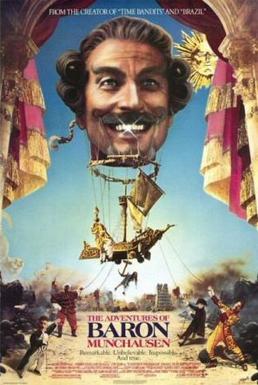So you go to the vending machine to buy a candy bar. And as you’re deciding what to pick, you notice that the candy bar in slot B5 is hanging there by the edge of the wrapper. Do you run and tell management? Do you call the service 800 number on the side of the machine? Hell no. You put in your money, press B5, you get two candy bars for the price of one, and you walk out of there quickly with a stupid grin on your face hoping nobody else sees you. Congratulations, son — you just pulled one over on the Man.
 I felt like that in 1989 when I saw Terry Gilliam’s masterpiece The Adventures of Baron Munchausen.
I felt like that in 1989 when I saw Terry Gilliam’s masterpiece The Adventures of Baron Munchausen.
My friends and I had been weaned on Monty Python, we could recite long passages from The Hitchhiker’s Guide to the Galaxy, we worshiped both Time Bandits and Brazil. So we had some idea of what to expect from a new Terry Gilliam film: visual surrealism, distrust of authority, antipathy to soulless reason, and a skewed sense of humor, among (many) other things. Pure chocolate-covered chaos covered in shiny tinfoil and encased in a neat plastic wrapper.
But Baron Munchausen was something else altogether. Imagine if someone tried to film Peter Jackson’s The Return of the King — without the benefit of CGI. It’s that grand of a scale. Gilliam gives us real armored elephants, ornately carved cannons, and hundreds upon hundreds of fully costumed soldiers engaging in mock battle. He gives us baroque, lovingly crafted setpieces and clockwork monsters that look like Muppets. He gives us cameos from Sting and Robin Williams, not to mention a stark naked Uma Thurman. There’s a story within a story within a story, with allusions to everything from Greek mythology to 1001 Nights.
My friends and I watched Munchausen with jaws dropped. Some Hollywood assholes had paid tens and tens of millions of dollars to make this movie. It was, at the time, one of the most expensive films ever made. And here we sat, on a Saturday afternoon, the day after opening — in Southern California, no less, the movie capital of the world — and there were less than 20 people in the audience.